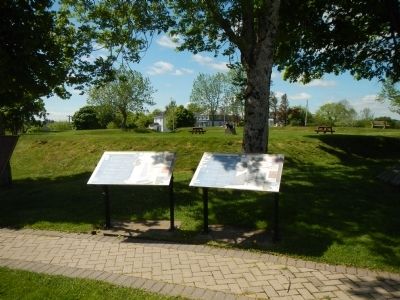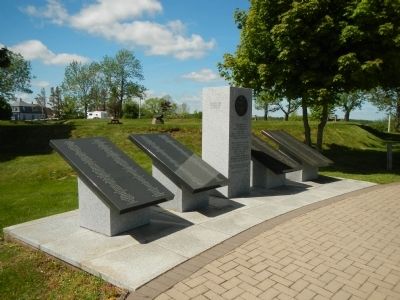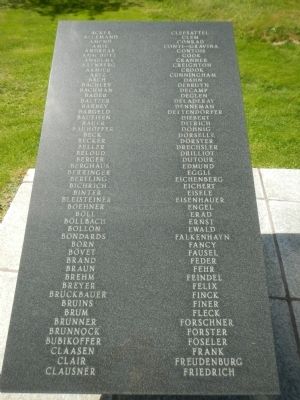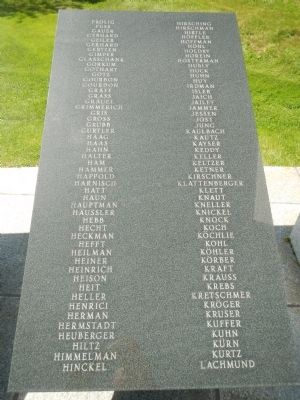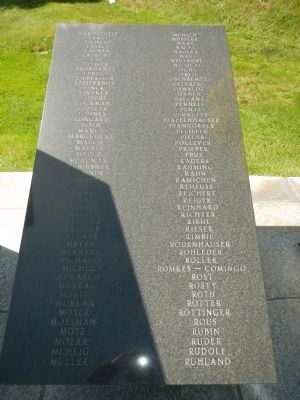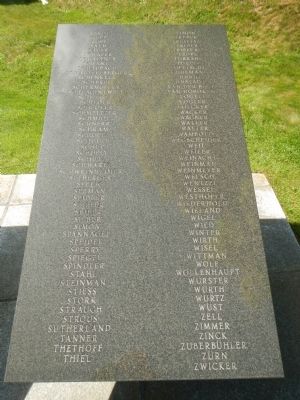Lunenburg in Lunenburg County, Nova Scotia — The Atlantic Provinces (North America)
Foreign Protestants & the Settlement of Lunenburg
La colonisation de Lunenburg par les protestants étrangers.
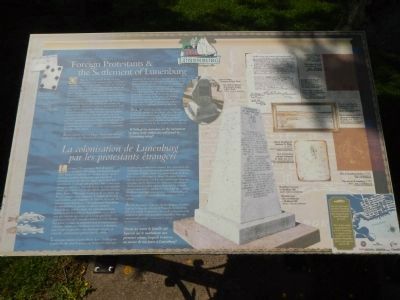
Photographed By Barry Swackhamer, June 16, 2014
1. Foreign Protestants & the Settlement of Lunenburg Marker
Captions (English / French): (top right) Settlers drew for Town lots listed on back of playing cards. / Les colons tirent au sort les lots de villes qui sont inscrits au dos de carters à jouer.; (right side, clockwise from the top) Original town plan of Lunenburg, 1753. / Plan original de la ville de Lunenburg, 1753.; View of Lunenburg from Southwest by Lieutenant H. Pooley, 1816. / Vue de Lunenburg prise de sud-ouest, de lieutenant H. Pooley, vers 1816.; Plan of Lunenburg Harbour, 1753. / Plan du port de Lunenburg, 1753.; Montbéliard monument on Blockhouse Hill. / Monument aux colons montbéliardais à Blockhouse Hill.; Map of Lunenburg by Lieutenant H. Pooley, c 1821. / Cart de Lunenburg tirée par le lieutenant H. Pooley, vers 1821.; Grant from the King for public spaces to hold in trust for the community. / Charte royale concédant des terrains publics en fidéicommis pour la collectvite.
On June 8, 1753, a small flotilla of ships carried 1453 settlers protected by 150 troops and militia, arrived at the harbour which the Mi’kmaq called Merligueche after the whitecaps that topped the waves in the harbour. This group was drawn from 2000 “Foreign Protestants” who had arrived in Nova Scotia over the previous three years from farming districts along Germany’s Upper Rhine river. They had come mostly from the German Palatinate, the adjoining Swiss cantons, and the French-speaking principality of Montbéliard, to escape religious persecution , high taxes, and overcrowding. Although most were farmers, they reflected a wide variety of trades and occupations, and were better educated than the settlers who had accompanied Governor Edward Cornwallis to Halifax in 1749. During the years in Halifax, they had impressed colonial officials as honest and industrious workers, just the kind of people needed to establish new communities throughout the colony.
British military surveyor Charles Morris soon laid out a plan for the new Town on a grid system used extensively by the British in colonial settlements. Free land, building materials and provisions had been promised back in Halifax, and after an initial period of suspicion, the new Governor, Colonel Peregrine Hopson, made good on the promises. Lots were drawn for and under military and civilian leadership chosen from among the settlers themselves, work on the new community progressed quickly. A palisade and four blockhouses were built to protect the settlement, timber was cut and land cleared for farming.
By the later 1700’s, the settlers soon turned their hand to the pursuit of the fishery along the coast of Nova Scotia and beyond. These German and French-speaking settlers, from different religious congregations, worked together to build a prosperous community based on the sea and the riches it offered.
Which of the surnames on the monument to these early settlers are still found in Lunenburg today?
French
Le 8 juin 1753, une petite flotte de navires transportant 1 453 colons, sous la protection de 150 militaires et miliciens, accoste dans le port que les Mi’kmaq appellent Merligueche, qui veut dire le moutonnement que font les vagues dans le port. Les membres de ce groupe sont issus des 2 000 «protestants étrangers» arrivés en Nouvelle-Écosse au cours des trois années précédentes à partir des régions agricoles du haut Rhin, fleuve d’Allemagne. La plupart de ces colons, qui fuient les persécutions religieuses, les impôts élevés et la surpopulation, sont originaires du Palatinat allemand, des cantons suisses environnants et de la principauté francophone de Montbéliard.
Le groupe est surtout composé d’agriculteurs, mais ils compte des représentants d’une grande variété de métiers et de professions. Ces colons sont plus instruits que ceux qui accompagnaient le gouverneur Edward Cornwallis à Halifax en 1849. Pendant leur séjour à Halifax, ils impressionnent les fonctionnaires coloniaux comme des travailleurs honnêtes et industrieux, juste le type de gens dont on a besoin pour fonder de nouvelles communautés partout dans la colonie.
L’arpenteur militaire Charles Morris dresse un plan pour la nouvelle ville selon le système de damier très utilisé par les Britanniques dans leur colonies. Des concessions, des matériaux de construction et des fournitures son promis aux colons à Halifax. Après une courte période de doute, le nouveau gouverneur, le colonel Peregrine Hopson, exécute la promesse. Les lots sont attribués par tirage au sort, puis sous la direction des militaires et de meneurs choisis parmi les colons mêmes, le travail à la nouvelle communauté avance rapidement. Une palissade et quatre blockhaus sont érigés pour protéger l’établissement, du bois est coupé et les terres défrichées pour en faire la culture.
À la fin des années 1700, les colons commencent à faire à pêche le long des côtes de la Nouvelle-Écosse et au-delà. Ces colons d’expression allemande et française et de confessions différentes travaillent ensemble à bâtir une communauté prospère basée sur la mer et ses richesses.
Parmi les noms de famille qui figurent sur le monument aux premiers colons, lesquels trouve-t-on encore de nos jours à Lunenburg?
Erected by Town of Lunenburg.
Topics. This historical marker is listed in this topic list: Settlements & Settlers. A significant historical month for this entry is June 1782.
Location. 44° 22.665′ N, 64° 18.268′ W. Marker is in Lunenburg, Nova Scotia, in Lunenburg County. Marker is at the intersection of Blockhouse Hill Road and Townsend Street, on the left when traveling north on Blockhouse Hill Road. Touch for map. Marker is at or near this postal address: 206 Blockhouse Hill Road, Lunenburg NS B0J, Canada. Touch for directions.
Other nearby markers. At least 8 other markers are within walking distance of this marker. Defence of Lunenburg (here, next to this marker); The Sack of Lunenburg (here, next to this marker); Lunenburg’s Shipbuilding Tradition (approx. 0.3 kilometers away); Rum Running (approx. 0.4 kilometers away); “…for those in peril on the sea.” (approx. half a kilometer away); Lunenburg - Home of the Bluenose & Bluenose II (approx. half a kilometer away); Lunenburg’s Fishing Industry Since 1940’s (approx. half a kilometer away); The Labrador Whaler Anderson Bros. (approx. 0.6 kilometers away). Touch for a list and map of all markers in Lunenburg.
Additional commentary.
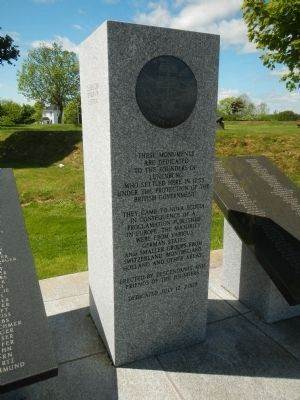
Photographed By Barry Swackhamer, June 16, 2014
4. Monuments to the Foreign Protestants
These monuments are dedicated to the founders of Lunenburg who settled here in 1753 under the protection of the British Government.
They came to Nova Scotia in consequence of a proclamation published in Europe. The majority were from various German States, and smaller groups from Switzerland, Montbéliard, Holland and other areas.
Erected by the descendants and friends of the founders.
Dedicated July 12, 2003
1. Jeanperrin
My name is David Perrin Watson and I am a descendant of the Jeanperrin listed on the Speedwell side of this monument. I grew up north of Boston and now live in Virginia. There were five David Perrins in my expended family - either as a last name or a middle name. I understand that the Perrins lived for awhile in River John, Nova Scotia.
— Submitted November 12, 2023, by David Perrin Watson of Lorton, Virginia.
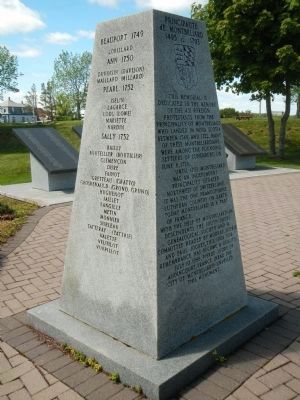
Photographed By Barry Swackhamer, June 16, 2014
9. Monument to the Foreign Protestants from the Principality of Montbéliard
Principality of Montbéliard
who landed in Nova Scotia between 1749 and 1752. Many of these Montbéliardians were among the founding settlers of Lunenburg on June 8, 1753.
Until 1793 Montbéliard was an independent principality situated northwest of Switzerland. It was the one francophone Lutheran county on earth. Today Montbéliard is part of France.
With the help of Montbéliardian descendants, the South Shore Genealogical Society and a committee headed by Murry Jodrie and Paul Jodrey, this idea for remembrance has becalm a reality.
July 10, 1988, Pierre Jodry of Audincourt, France (near the city of Montbéliard) unveiled this monument.
This monument listed the surnames of the settlers from the Principality of Montbéliard. Click on the image to enlarge it.
Credits. This page was last revised on November 30, 2023. It was originally submitted on October 26, 2014, by Barry Swackhamer of Brentwood, California. This page has been viewed 3,248 times since then and 275 times this year. Photos: 1, 2, 3, 4, 5, 6, 7, 8, 9, 10. submitted on October 26, 2014, by Barry Swackhamer of Brentwood, California. • Andrew Ruppenstein was the editor who published this page.
